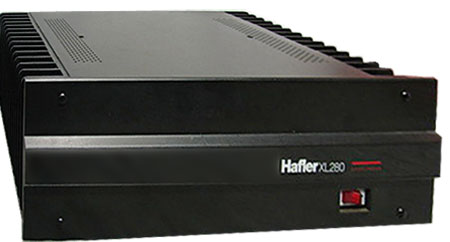| Columns Retired Columns & Blogs |
Hafler XL-280 power amplifier
Some time ago in these pages, Anthony H. Cordesman observed rather ungraciously that the whole line of Hafler electronics "could do with reworking." This was interpreted by many readers—including the good people at the David Hafler Company—as meaning that AHC felt the entire Hafler line to be mediocre. In fact, he does not. (He had given a Hafler product a positive review a few issues previously.) Tony's comment, however, did express a sentiment that most of us at Stereophile have shared for some time: a feeling that Hafler products had slipped from the position of sonic preeminence which they enjoyed during the 1960s and '70s to one of mere excellence in a field where only preeminence is acclaimed.
Footnote 1: For a full description of the straight wire differential test, see the article in this issue.

These days, most audio perfectionists see Hafler products as ranking about halfway between the mainstream mid-fi of Sansui and Akai and the cutting-edge leadership of, for example, Krell and Threshold. It is not that Hafler products are perceived as being mediocre; just that they are not considered to be among the products one would choose were cost no object.
Actually, Hafler has never tried to go the cost-no-object route. Affordability has been an important aspect of David Hafler's products ever since he founded The Dyna Company back in the mid 1950s. But what put Hafler on the map to begin with was the fact that the low prices would also buy you close to the best-sounding amplifiers that any amount of money could buy. It was a case of price-no-object-in-reverse: a modest outlay brought you sound that made McIntosh owners feel as if they had been had! It is that cutting-edge image of the Hafler line which has seemed lacking in recent years. Their new XL-280 amplifier may represent the first "reworking" of Hafler products that AHC had in mind.
David Hafler, an engineer of the "old school," holds as an article of faith that there is no magic in audio. He scoffs at the audiophile preoccupation with sonic differences so slight that their audibility is still open to question, yet believes that any sonic imperfection which does exist is objectively measurable, if we can just find a measurement for it. This actually hews very close to our own views on the matter.
Since there are probably things going on in amplifiers that we don't, as yet, have tests for, David decided to look for a test which would detect all forms of distortion, including those not yet identified. It didn't have to identify or quantify them; merely show whether or not they were present in an amplifier's output. A version of the venerable null test—which Hafler has dubbed the Straight-Wire Differential Test—seemed best to meet this requirement (footnote 1).
The XL-280—dubbed the Excelinear amplifier (for "Excels in Linearity")—is, according to Hafler, the first amplifier ever designed to meet the extremely stringent demands of the SWDT, which is probably true. But the XL-280 is also, to my knowledge at least, the first amplifier a manufacturer has claimed to be perfect. Hafler did not make that statement, exactly. But a company Q&A sheet about Excelinear answers the question "Is it perfect?" with "[The XL-280] has reached the practical limits of audible distortion for its power class." That sounds like "Yes" to me.
The SWDT does appear to be a definitive test for an amplifier's accuracy. I find no basis for faulting it. So an amplifier which gives a complete, total, 100%, infinite-decibel null across the entire frequency band on that test can very probably be considered a perfectly accurate amplifier. Unfortunately, no amplifier does achieve such a result, including the XL-280.
What Does the Null Test Mean?
According to Hafler, the XL-280 achieves "up to 70dB of nulling in the midband and about 60 over most of the rest of the audio spectrum." (On the other hand, their own null figures for the 280 show 70dB at 10kHz and around 65 through the midrange.) These are impressive test results, particularly in comparison with earlier efforts to obtain a straight-wire null against real-world amplifiers, but are they good enough to offer conclusive proof of perfection?
An attenuation of 70dB produces a signal less than one three-thousandth the amplitude of the original (0.0003 of the original), therefore distortion at this level, just 0.03%, would be a very respectable figure by anyone's accounting. But is it low enough to be completely inaudible? Well, assume we're listening at an average SPL of 90dB to an amplifier producing 0.03% spurious content at 10kHz. A level of 70dB below 90dB SPL is 20dB (surprise!), a level at which 10kHz is very clearly audible in the absence of other sounds which would otherwise mask it. And, there, of course, is the catch.
Footnote 1: For a full description of the straight wire differential test, see the article in this issue.
- Log in or register to post comments




































